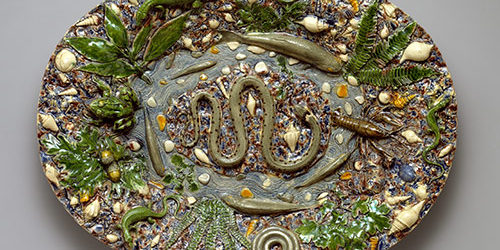Excerpt
Bernard Palissy and His School
The serious study of nature crops up in the work of the ceramist Bernard Palissy (1510–1590), as well as in that of other artists and architects like Philibert De L’Orme. Toward the end of his career, Palissy established a “little academy” in Sedan, in northeastern France, and gave lectures on the natural sciences there and in Paris that were published as the Discours admirables in 1580. Untutored in Latin and Greek , Palissy’s knowledge was practical and based on direct observation. He kept a cabinet of curiosities, and this spirit of taxonomy transferred delightfully to the surface of what he called rustiques figulines [sic]. Palissy developed a method of molding from fauna and flora and applying the casts as decoration to large basins. Having closely observed the locomotion of animals, he transformed the slithering or coiling of snakes into motifs that invigorated his clay compositions. Textures of ferns and leaves contrast with the shiny spiral of the nautilus or sharp rim of the scallop, as he created works that mimic the habitat of a riverbank yet resolve into artistic order. His compositions read sometimes as parables: the cunning serpent preys on innocent creatures , or, in the tradition of tomb symbolism, snakes and frogs may represent the corruptibility of human flesh, while shells stand for eternal life. These tales in clay come brilliantly to life through stunning colors . Having begun his career as a stained-glass artist in Saintes, Palissy experimented with many enamel hues to achieve a rich palette of glazes.
Ian Wardropper
Department of European Sculpture and Decorative Arts, The Metropolitan Museum of Art
April 200
